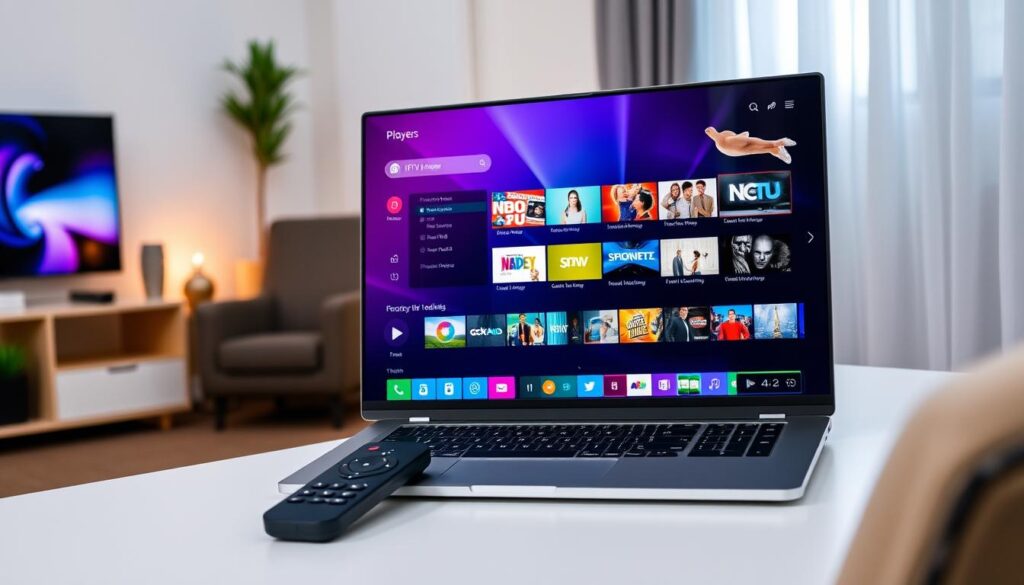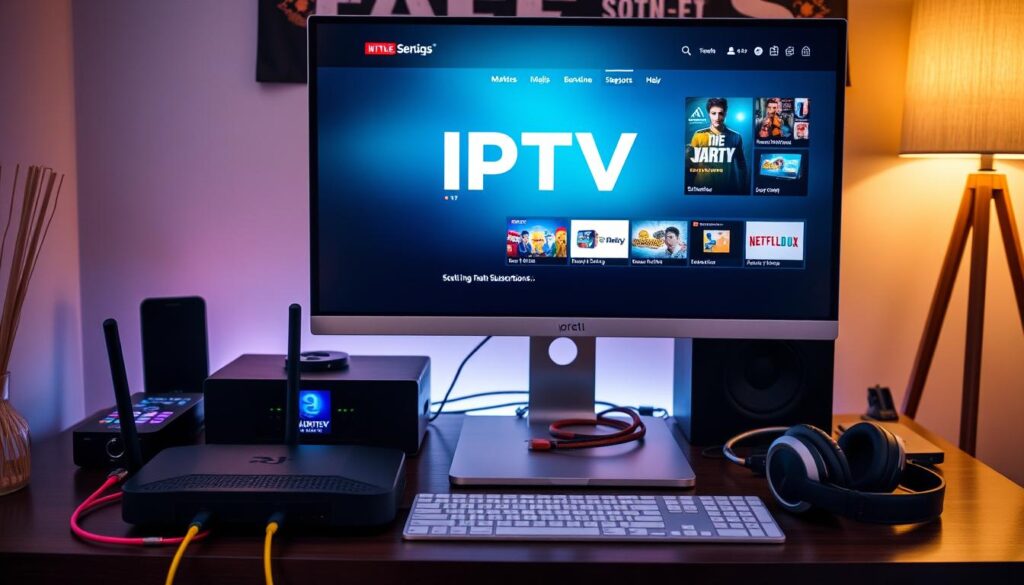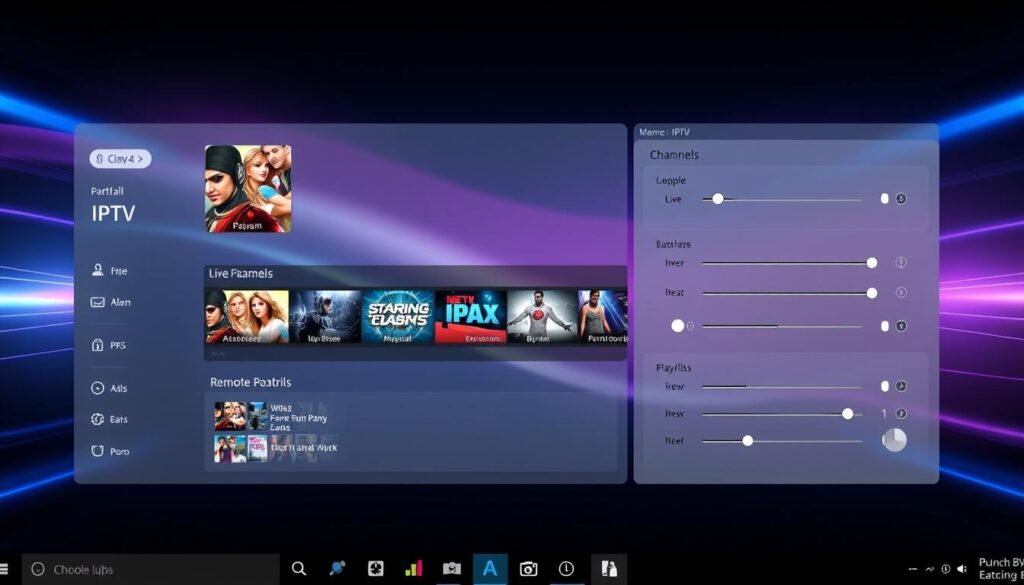How to setup iptv on windows
To start with IPTV on Windows, you need to know the basics. IPTV lets you stream your favourite shows and channels to your Windows media player. This gives you a top-notch viewing experience. With a good internet connection, you can enjoy smooth IPTV streaming.

Setting up IPTV on Windows is easy. You just need a good IPTV provider and a compatible media player. By following simple steps, you can open up a world of entertainment. You’ll get access to lots of channels and shows, all from home.
Key Takeaways
- Understanding the basics of IPTV setup is crucial for a seamless viewing experience
- A stable internet connection is essential for IPTV streaming on Windows
- Choosing a reliable IPTV provider is vital for uninterrupted service
- Windows media player compatibility is necessary for IPTV setup
- IPTV streaming offers an unparalleled viewing experience with access to a wide range of channels and programmes
- IPTV setup on Windows is relatively straightforward and easy to install
Understanding IPTV and Its Benefits for Windows Users
IPTV, or Internet Protocol Television, lets users stream TV channels and on-demand content over the internet. With an IPTV subscription, you can watch a wide range of channels. This includes live TV, movies, and TV shows.
One big plus of using IPTV on Windows is watching content anywhere, anytime. It’s great for watching your favorite TV shows or sports events on the go. IPTV players also have an easy-to-use interface. This makes it simple to find and watch what you want.
What is IPTV?
IPTV uses internet protocol to deliver TV channels and video content. It’s different from traditional TV, which uses satellite or cable signals.
Advantages of Using IPTV on Windows
Using IPTV on Windows has several benefits:
- Access to a wide range of IPTV channels, including live TV, movies, and TV shows
- Ability to stream content from anywhere, at any time
- User-friendly interface for navigating and selecting channels
Legal Considerations and Requirements
It’s important to note that using IPTV needs a valid subscription and following copyright laws. Users should only use IPTV players and services that offer legal access to channels and content.
Essential Prerequisites for IPTV on Windows
To set up IPTV on your Windows, you need a few key things. First, a stable internet connection is vital for a good IPTV experience. You also need a Windows version that supports IPTV and the right media players or software.
Make sure your Windows is up to date for IPTV support. You can check your version and update if needed. For IPTV, pick a media player like VLC or Kodi that works well with IPTV streams.
Here are some important things to think about for IPTV on Windows:
- A stable internet connection with a minimum speed of 10 Mbps
- A compatible Windows operating system, such as Windows 10 or later
- A reliable media player, such as VLC media player or Kodi
With these basics covered, you’re set for a great IPTV experience on Windows. Always choose a legitimate IPTV provider and follow guidelines for a safe and fun time.
System Requirements for Smooth IPTV Streaming
To enjoy seamless IPTV streaming on your Windows device, make sure your system meets the necessary requirements. You’ll need a powerful processor, enough RAM, and a graphics card that’s compatible. For example, a minimum of 4GB RAM and a dual-core processor can ensure a smooth experience with Windows media player or other IPTV players.
Minimum Hardware Specifications
The minimum hardware specs for IPTV streaming include a processor speed of at least 2.0 GHz. You’ll also need 4GB of RAM and a graphics card that supports DirectX 11. Plus, a 64-bit operating system is recommended for the best performance.
Recommended Internet Speed
A stable internet connection with a minimum speed of 25 Mbps is needed for smooth IPTV streaming. But, for high-definition streaming and to avoid buffering, a faster internet speed of 50 Mbps or more is recommended.
Operating System Compatibility
IPTV streaming works well with various Windows operating systems. This includes Windows 10, Windows 8, and Windows 7. Make sure your operating system is up-to-date to avoid any compatibility issues with IPTV players or Windows media player.
By meeting these system requirements, you can enjoy uninterrupted IPTV streaming on your Windows device. You can use your preferred IPTV players or Windows media player.
| Requirement | Minimum Specification | Recommended Specification |
|---|---|---|
| Processor Speed | 2.0 GHz | 2.5 GHz or faster |
| RAM | 4GB | 8GB or more |
| Internet Speed | 25 Mbps | 50 Mbps or faster |
Popular IPTV Players for Windows
Watching IPTV on Windows needs the right player. There are many IPTV players out there, each with special features. VLC media player and Windows media player are two of the most popular.
These players have many benefits. They are easy to use, work with different formats, and can be customised. For instance, VLC media player can play lots of file types. This makes it perfect for those with varied media collections.
When picking an IPTV player, consider these key features:
- Support for multiple formats, including MP4, AVI, and MKV
- Customisation options, such as skinning and plugin support
- Ease of use, with intuitive interfaces and simple navigation
Besides VLC media player and Windows media player, there are many other IPTV players for Windows. It’s important to think about your needs and preferences. This way, you’ll find the best player for your IPTV watching.
Setting Up IPTV on Windows Using VLC Media Player
To set up IPTV on Windows with VLC media player, start by downloading and installing VLC. This is easy and takes just a few minutes.
After VLC is installed, you can set it up for IPTV. Go to the preferences menu and choose the IPTV setup option. This lets you add your IPTV playlist and streams, giving you lots of channels and content.
Downloading and Installing VLC
Downloading and installing VLC is simple. Get it from the VLC website and follow the prompts to install it on your Windows device.
Configuring VLC for IPTV
Setting up VLC for IPTV is easy. Go to the preferences menu, pick the IPTV setup option, and add your playlist and streams. This lets you watch your favorite shows and movies.
Adding Playlist and Streams
Adding your IPTV playlist and streams to VLC is straightforward. Access the preferences menu, choose the IPTV setup option, and add your playlist and streams. You can add many playlists and streams, giving you lots of channels and content.
Here is a table summarizing the steps to set up IPTV on Windows using VLC media player:
| Step | Description |
|---|---|
| 1 | Download and install VLC media player |
| 2 | Configure VLC for IPTV |
| 3 | Add IPTV playlist and streams |
By following these steps, you can set up IPTV on Windows using VLC media player. Start watching your favorite shows and movies. VLC media player offers smooth IPTV streaming and access to many channels and content.
Alternative Methods for IPTV Installation
If you don’t want to use VLC media player, there are other ways to set up IPTV. You can use Windows media player, which is easy to use and doesn’t need extra software.
Another choice is to use IPTV players like Kodi or Simple IPTV. These offer more features and can be customized. They also support EPG and recording.
- Windows media player: a straightforward option for playing IPTV streams
- Kodi: a popular media player that supports IPTV and offers additional features
- Simple IPTV: a lightweight player that is easy to use and customize
When picking an alternative, think about the player’s features and how well it works. Some players have more features but can be harder to use. Your choice should match your needs and what you like.

In summary, there are many ways to set up IPTV, each with its own benefits and drawbacks. By looking at what each player offers, you can find the best one for you.
| Player | Features | Compatibility |
|---|---|---|
| Windows media player | Basic playback capabilities | Windows operating system |
| Kodi | EPG support, recording capabilities, customization options | Windows, Linux, macOS |
| Simple IPTV | Lightweight, easy to use, customization options | Windows, Linux, macOS |
Troubleshooting Common IPTV Issues on Windows
Using IPTV on Windows can sometimes cause problems. These might include buffering, playback errors, or connection issues. Finding out what’s wrong and fixing it is key.
Buffering Problems
Buffering is a common problem with IPTV, especially on Windows. It often happens if your internet is slow or if the video quality is too high. Try lowering the video quality or checking your internet speed to fix it.
Playback Errors
Playback errors can pop up for many reasons. This includes video formats not working or files being damaged. Make sure your Windows media player is up to date and works with your IPTV service.
Connection Issues
Connection problems can be a real hassle, especially when you can’t get to your favorite channels. Check your internet, restart your router, or reach out to your IPTV provider for help.
To solve IPTV problems on Windows, try these steps:
- Check your internet connection and speed
- Update your Windows media player
- Restart your device and router
- Contact your IPTV provider for assistance
By taking these steps and figuring out the problem, you can fix common IPTV issues on Windows. This will help you enjoy smooth IPTV streaming.
| IPTV Issue | Cause | Solution |
|---|---|---|
| Buffering Problems | Slow internet connection | Reduce video quality or check internet speed |
| Playback Errors | Incompatible video formats | Update Windows media player |
| Connection Issues | Internet connection problems | Check internet connection, restart router, or contact IPTV provider |
Optimising Your IPTV Experience
To enjoy your IPTV to the fullest, a stable internet connection is key. A wired connection is best for smooth streaming. It cuts down on buffering and playback errors. Using a Windows media player can also boost your viewing experience.
For the best video quality, tweak your IPTV player settings to match your internet speed. A device with a top-notch processor is also crucial for smooth streaming. Brands like Samsung and LG are known for their quality IPTV devices.
Here are some tips to make your IPTV experience better:
- Use a wired internet connection for smooth streaming
- Adjust the video quality settings to suit your internet speed
- Use a device with a high-quality processor for seamless streaming
By following these tips, you can enjoy top-notch IPTV with less buffering and errors. Always choose a reputable IPTV provider and check if the service is legal in your area.
With the right gear and settings, you’re set for a fantastic IPTV experience with your Windows media player. So, why not give it a go and start streaming your favourite shows and movies today?
Advanced Features and Customisation Options
After setting up your IPTV on Windows, you can dive into advanced features and customisation options. These can make your viewing experience better and give you more control over your IPTV setup.
Some top IPTV features include EPG integration, recording setup, and making your interface personal. These options let you tailor your IPTV experience to your liking.
EPG Integration
EPG (Electronic Programme Guide) integration lets you see a schedule of upcoming shows. This is great for planning your TV time, especially for live TV and sports.
Recording Setup
With recording setup, you can save your favourite shows to watch later. It’s perfect for those with tight schedules who can’t watch live.
Interface Personalisation
Interface personalisation lets you change how your IPTV looks and feels. You can pick a theme, layout, and more to make it your own and easy to use.
You can also use Windows media player to watch your recorded shows. Plus, there are more IPTV customisation options. These features help you create a custom IPTV experience that fits your needs and preferences.

| Feature | Description |
|---|---|
| EPG Integration | Access a schedule of upcoming programmes |
| Recording Setup | Record your favourite programmes and watch them later |
| Interface Personalisation | Customise the look and feel of your IPTV interface |
Security and Privacy Considerations
When using IPTV on Windows, it’s key to think about IPTV security and IPTV privacy. This helps protect your device and personal info. Using a Virtual Private Network (VPN) is a good way to keep your stream safe while using Windows media player.
To boost IPTV security, make sure your device and software are current. Old systems can be at risk of malware and cyber threats. Keeping your Windows media player and other software updated helps fix security holes.
Here are some tips for IPTV privacy and security:
- Use a reputable VPN service to encrypt your internet connection
- Keep your device and software up to date
- Avoid using public Wi-Fi or unsecured networks to stream IPTV content
By following these tips, you can have a safe and private IPTV experience on your Windows device with Windows media player.
Maintaining and Updating Your IPTV Setup
To keep your IPTV experience smooth, regular IPTV maintenance is key. This means checking for IPTV updates and installing the latest software. This prevents bugs and glitches. Keeping your system updated ensures uninterrupted streaming and access to new features and channels.
Using a reliable media player, like Windows media player, can also improve your IPTV experience. Its user-friendly interface and advanced features make managing playlists and streams easy.
Regular Maintenance Tips
- Check for software updates regularly
- Clear cache and cookies to improve streaming quality
- Restart your device periodically to prevent overheating
Keeping Software Updated
It’s vital to keep your IPTV software updated for a smooth viewing experience. Look for IPTV updates and install the latest version. This ensures you have the latest features and security patches.
Playlist Management
Managing your playlists is simple with Windows media player. You can create and edit playlists, add or remove channels, and customize your streaming experience. This lets you tailor it to your preferences.
| Feature | Description |
|---|---|
| Playlist Management | Create and edit playlists, add or remove channels |
| Software Updates | Install the latest IPTV updates for a seamless viewing experience |
| Regular Maintenance | Check for software updates, clear cache and cookies, and restart your device periodically |
Conclusion
Setting up IPTV on your Windows device opens a world of entertainment. You can watch live TV and on-demand content. It’s all about choosing a good IPTV provider, having a strong internet connection, and using the right media players.
To get the most out of IPTV, keep your software and security up-to-date. Regular maintenance is key. Also, explore features that make watching TV better. A good IPTV setup means lots of content and keeping your data safe.
Starting your IPTV adventure means enjoying flexibility and convenience. With the right knowledge, your Windows device can become a media hub. It unlocks endless entertainment right at your fingertips.
FAQ
What is IPTV?
IPTV stands for Internet Protocol Television. It lets you watch live TV and on-demand videos on your Windows devices over the internet.
What are the advantages of using IPTV on Windows?
IPTV on Windows offers many benefits. You get access to lots of channels and on-demand content. Plus, you can watch from anywhere with a good internet connection. It’s more interactive and personal than traditional TV.
What are the legal considerations for using IPTV?
To use IPTV legally, you need a valid subscription from a licensed provider. Make sure you follow copyright laws. Always choose a reputable IPTV service and avoid illegal streaming.
What are the minimum hardware and software requirements for IPTV on Windows?
For good IPTV streaming on Windows, you need a compatible OS, fast internet (at least 5Mbps), and a media player like VLC or Windows media player.
What are some popular IPTV players for Windows?
VLC media player and Windows media player are top choices for Windows IPTV. They make setting up IPTV easy and support many video formats. You can also customise them for a better viewing experience.
How do I set up IPTV on Windows using VLC media player?
To set up IPTV with VLC on Windows, download and install VLC, then configure it for IPTV. Add your IPTV playlist and streams. VLC’s interface makes the process straightforward.
What are some common IPTV issues on Windows and how can I troubleshoot them?
Issues like buffering, playback errors, and connection problems are common. Try improving your internet speed, check your media player settings, and look for software or hardware conflicts.
How can I optimise my IPTV experience on Windows?
For a better IPTV experience, tweak your media player settings for better video quality. Use a wired connection for stability. Explore features like EPG integration and recording setup.
What are some security and privacy considerations for IPTV on Windows?
When using IPTV on Windows, protect your online activities with a VPN. Keep your software updated and be wary of malware or phishing attempts that could harm your device or personal info.
How can I maintain and update my IPTV setup on Windows?
Keep your IPTV setup in top shape by updating your media player, managing playlists, and checking for system issues regularly. This ensures a smooth IPTV experience.
